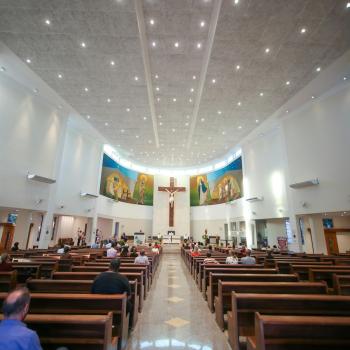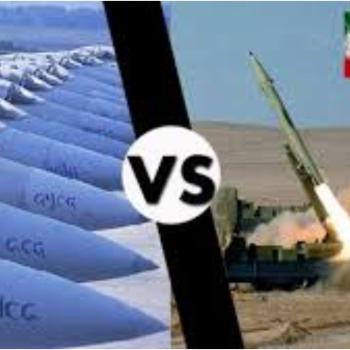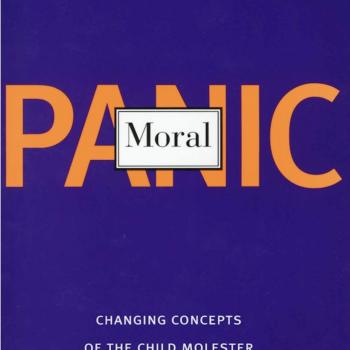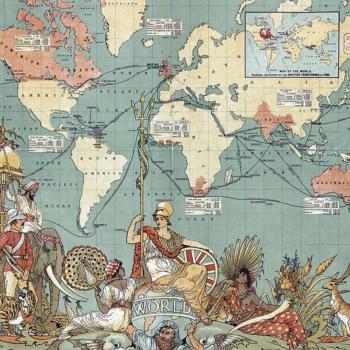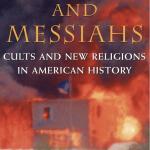I recently posted on the question of Christian numbers around 200 AD. Since then, I have read a new book that is a significant contribution on the subject, namely Thomas A. Robinson, Who Were the First Christians: Dismantling the Urban Thesis (Oxford University Press, 2017). This blogpost offers some reactions to that book and its thesis.
Most scholars of early Christianity agree that it was an overwhelmingly urban religion, and some major writers who have advanced numbers based on that approach are Wayne Meeks, Rodney Stark, and Ramsay MacMullen. (Just to confess an interest, Rod Stark is a colleague of mine at Baylor). Robinson offers a stern (and sometimes hyper-critical) challenge to these ideas, both what he terms the “Urban Thesis,” and the various numbers estimated for early Christianity – which do indeed vary alarmingly. The book’s arguments just can’t be ignored.
Throughout, Robinson asks some excellent and provocative questions, especially about the nature of our sources. What in fact can we say about population numbers overall, never mind how we approach more tenuous and subjective categories like “Christians”? He is correctly scornful of the extremely high and long discredited figures of Jews in the Empire. No, Jews never made up ten percent of the empire’s population, or anything close to it. And indeed, we should be very cautious about taking our literary sources – especially Christian apologists – as if they are presenting anything like objective fact.
As social scientists warn us, the plural of “anecdote” is not “data.” Nor does a bogus figure gain value merely by the fact of constant repetition. Among other virtues, Robinson offers a good history of statistical mythologies.
Robinson particularly develops one sequence that proceeds logically thus. A common consensus holds that by around 300, Christians represented some ten percent of the total population of the Roman Empire. (That figure dates back to a century old guesstimate by von Harnack, but has since found wider support). The urban population of the Roman Empire was around ten percent. If both those figures are correct, then Roman cities would already have been overrun with Christians, leaving no room for Jews or even pagans. Therefore, suggests Robinson, if that figure of ten percent Christian is even vaguely accurate, then we are missing a great many non-urban Christians. And therefore, we need to pay a lot more attention to the presence of early rural Christianity, which forms a major topic of his book. The existence of such a large rural component so early in the Christian story runs flat contrary to virtually all the scholarly literature.
I would have found this argument more of a knockdown if Robinson’s own Preface had not spoken of Christians in the countryside, “where at least 80 percent of the empire’s population lived.” That would leave the empire’s urban proportion as a bit under twenty percent, rather than ten, and that would have left plenty of room in the cities for all those supposed Christians, not to mention Jews, pagans, and miscellaneous other groups. So that is quite an inconsistency, especially if we are trying to be precise about numbers.
But let’s pursue that rural theme. Robinson duly cites recent studies of rural churches and Christian communities, many of which have only received full scholarly attention. This is important and highly relevant material. But how large a share were they of the whole Christian community? One question would be just why those communities are so utterly neglected in the quite extensive Christian writing we do have from the era between, say, 120 and 320. Obviously city dwellers tend mainly to write about cities, and literate elites despise peasants. But at some point, if in fact Christianity was anything like the force Robinson suggests, it would be such an overwhelming temptation to state this outright.
You can almost imagine Tertullian proclaiming that Christianity was sweeping the ranks of the world’s most despised, that we surround your great pagan cities, all supported by some appropriate agricultural metaphors about planting, seed, and harvest. God’s countryside surrounds the cities that are the fortresses of the Devil…. But he doesn’t. There is no such literature anywhere, is there? Why not?
As Robinson properly notes, anti-Christian critics like Celsus denounced the low-born, low-class and even criminal component of early Christian churches, and they may have had a point about the faith’s cross-class appeal. That is quite different though from suggesting broad masses of rural peasant believers.
One theme that Robinson’s book must make us consider is the whole question of what constitutes urban, against rural, and when that divide fades to the point of vanishing. In a sense, both urban and rural are strictly relative terms. (His chapter five is very good on this). There are degrees of urban, and degrees of rural.
If we are looking at Rome or Alexandria or Ephesus, then very clearly we are talking about cities and urban life in the purest sense, but the great majority of Roman cities were far smaller concerns, and by definition, they were much closer to the surrounding countryside. Often, cities would be surrounded by a network of smaller towns or settlements, some military or commercial in nature, or transportation centers, which might be small in themselves, but which would fall under the general umbrella of the City of X. Modern geographers include such outliers within the “metropolitan region” of a given city.
Throughout history too, the process of rapid urbanization often leaves many people straddling the urban-rural divide. Imagine for instance a Roman province like Britain, where urban life only really arrived in the mid-first century AD, but cities then proliferated. By the fourth century, there were at least 22 towns with substantial defended areas of fifteen hectares or more, and the leading centers were really sizable – London covered 128 hectares, Cirencester 88, Verulamium-St.Alban’s 79, and Wroxeter stood at 77 hectares. Some of the urban inhabitants would be foreign migrants, including military veterans, but many would be British people who moved from the countryside, and quite recently.
Around twenty of the major British towns were civitas centers, or the capitals of tribal territories. Cirencester was the civitas of the Dobunni people, Wroxeter of the Cornovii. The assumption is that these towns would have had quite extensive and continuing contacts throughout their tribal region, which was roughly the size of a modern English county. If later historical examples are any guide, those new native city dwellers would not cut their ties with the countryside overnight, but would rather maintain networks of kin and friends. They would travel back to the countryside regularly, and country dwellers would visit them. Country dwellers often traveled to cities to sell produce. At elite social levels, wealthy people had sizable country estates, villas, which were usually only a few miles from flourishing cities like Gloucester and Cirencester. Such new growth was especially characteristic of the Western Empire, and particularly in Northern Gaul and the Rhineland.
Incidentally, such arguments about overlap and continuity are often made in the context of the urbanization associated with the Industrial Revolution, making the mushrooming new towns of that era much more rooted in the countryside than might initially appear. Workers in new industrial plants even went “home” to help their families with the harvest. Did the inhabitants of upstart Roman towns do the same?
A city, then, would cast a massive shadow over a surrounding region, creating a rural/urban penumbra. As Wayne Meeks observes, the network of towns and villages dependent on the city was the chora, and it would have fallen naturally under the power of the urban bishop (Robinson 22-23). It would be only natural for ideas to develop in cities, and to spread into these immediately surrounding regions, the urban-ish areas. These regions would be rural in a very different sense, and a radically different degree, from more distant regions separated from the whole Roman world of commerce and communication. If these areas near cities are not exactly suburban, or ex-urban, they are still intimately tied into urban life. If a modern US-style government somehow found itself in charge of the Roman Empire, it would incorporate many of these regions within something like our Metropolitan Statistical Areas, and we would be talking of (say) the Ephesus-Smyrna Metro Region.
So if we imagine a Christian community living a couple of miles outside a city, wholly dependent on that city in economic terms, and subject to its episcopal authority … is that an urban or a rural church? Interesting question.
If the urban/rural divide is questionable, so we need to be careful discussing “Early Christianity,” and chronology demands careful consideration. The term “Early Christian” might refer to the whole period from, say, AD 30 through 325, a three century era that is roughly the same as the time that separates us from, say, the birth of Ben Franklin. Things obviously change a great deal in such a time-span, and especially in the context of a new and booming movement like an emerging religion. It is quite possible to argue, for instance, that Christianity before 150 AD was near-totally urban, while it was developing a real rural outreach after 250. That chronology is roughly what I believe, but which Robinson challenges in his chapter seven.
I raise a major point of disagreement here. Robinson says that if indeed Christianity developed solidly in the countryside only after 250, then there is no way it could have become the popular mass movement it did by the fourth century. Ergo, there must have been significant rural growth before that, to provide the essential platform for later growth. But that argument assumes that the large rural presence we see from the fourth century onward represented spontaneous growth – that all the rural conversions and affiliations to Christianity after 300 or so are based on a rational series of religious choices, and that such choices are wholly voluntary. In fact, rural believers were highly subject to the whims of their elite neighbors and their landlords, who were often ferociously oppressive and exploitative. Rural elites could thus have imposed Christian practice vastly more rapidly than it appeared in the cities, especially when that was reinforced by state action against rural temples. An initial top-down imposition does not preclude the growth of authentic mass conversions in the next generation, or indeed the development of popular forms of Christian devotion.
To look at a later parallel, see how the near-solid Catholic countryside of late sixteenth century England became the fervent Protestant region of 150 years later. Why did that change happen? Because landlords insisted on the new faith, and so did an intrusive and often violent state. And gradually, that opened the door for ordinary people to follow the new faith of their own volition, and often on their own terms. The closer those rural regions were to Protestant cities, the faster and more complete the conversion.
Does any of that sound familiar in the world of Late Antiquity?
Robinson asks a great many good questions, and forces us to think about many of the conventional clichés and statements that we might be tempted to use about early Christian numbers. And yes, there were rural Christian communities from an early date. I don’t think, though, that he comes close to substantiating his claim about the relative importance of that rural element, and especially not over the whole span of Early Christian history (as opposed to just after 250). The “Urban Thesis” has not been dismantled.
I make one common sense argument. When Constantine opted to favor Christianity in 313, he was seeking the support of a movement that was widespread in the Empire, and which commanded a sizable share of support, especially in the East. I think that statement is uncontroversial enough? Obviously Constantine was not just aiming for the support of a few thousand fringe cultists and their hangers on. I don’t know if we can plausibly estimate the faith’s overall numbers at that time at ten percent, but surely – surely! – it must have been more than one or two percent. But how much more?
Or is it a mistake speaking of overall percentages at all? The Empire had no interest whatever in mass democracy. Imagine a situation where Christians made up (say) one percent of the total imperial population, but a quarter of the elites (I don’t propose those figures as valid, but suggest a hypothetical). In those circumstances, Constantine would have had a firm and comprehensible basis for his seemingly radical new turn.
But these are specific questions within a larger agenda. However many mistakes have in the past been made in seeking precise figures for Christian numbers, then the search itself absolutely is a legitimate enterprise.
For my British examples, see David Mattingly, An Imperial Possession (2006). On “urban” themes, I will just note here the impressive new collection edited by Steve Walton, Paul R. Trebilco, and David W.J. Gill, The Urban World and the First Christians (Eerdmans, 2017). I’ll have more to say about this in a later post.
I post quite a bit in late Roman/post-Roman topics, and I offer my working bibliography, which you can find here.
ADDENDUM: Professor Robinson has offered a thoughtful response to my review, for which see below.




